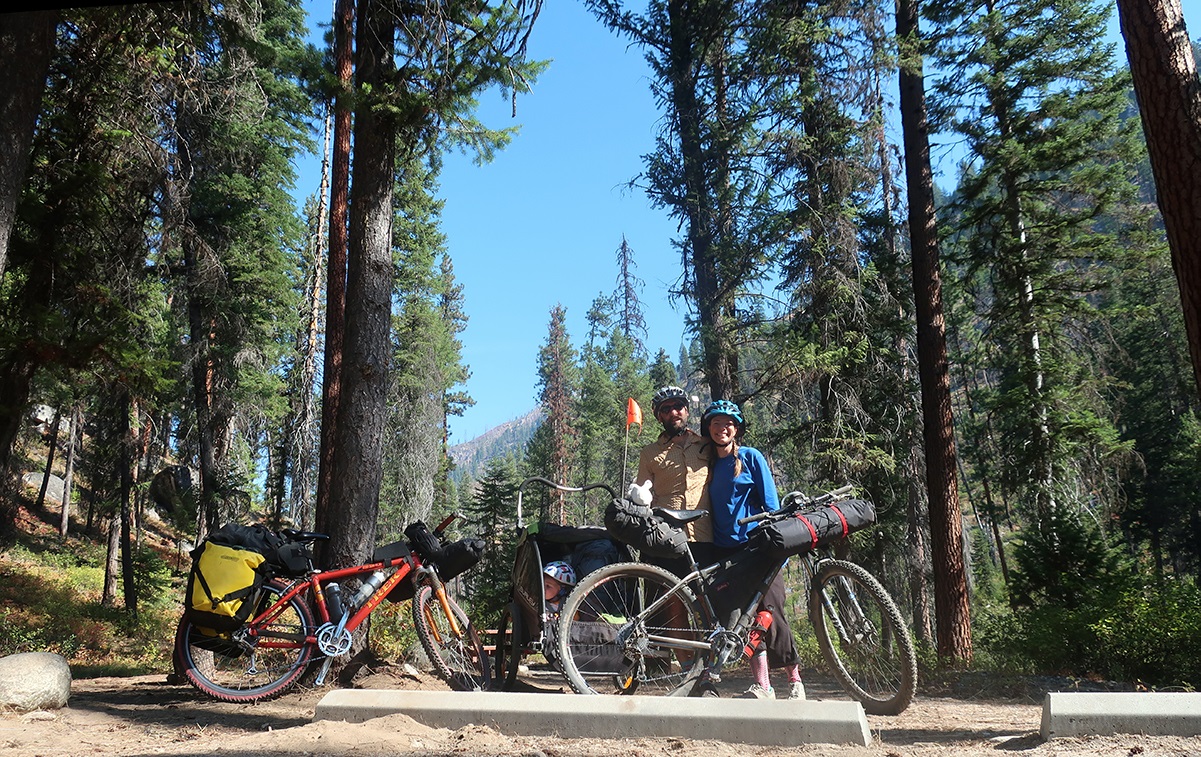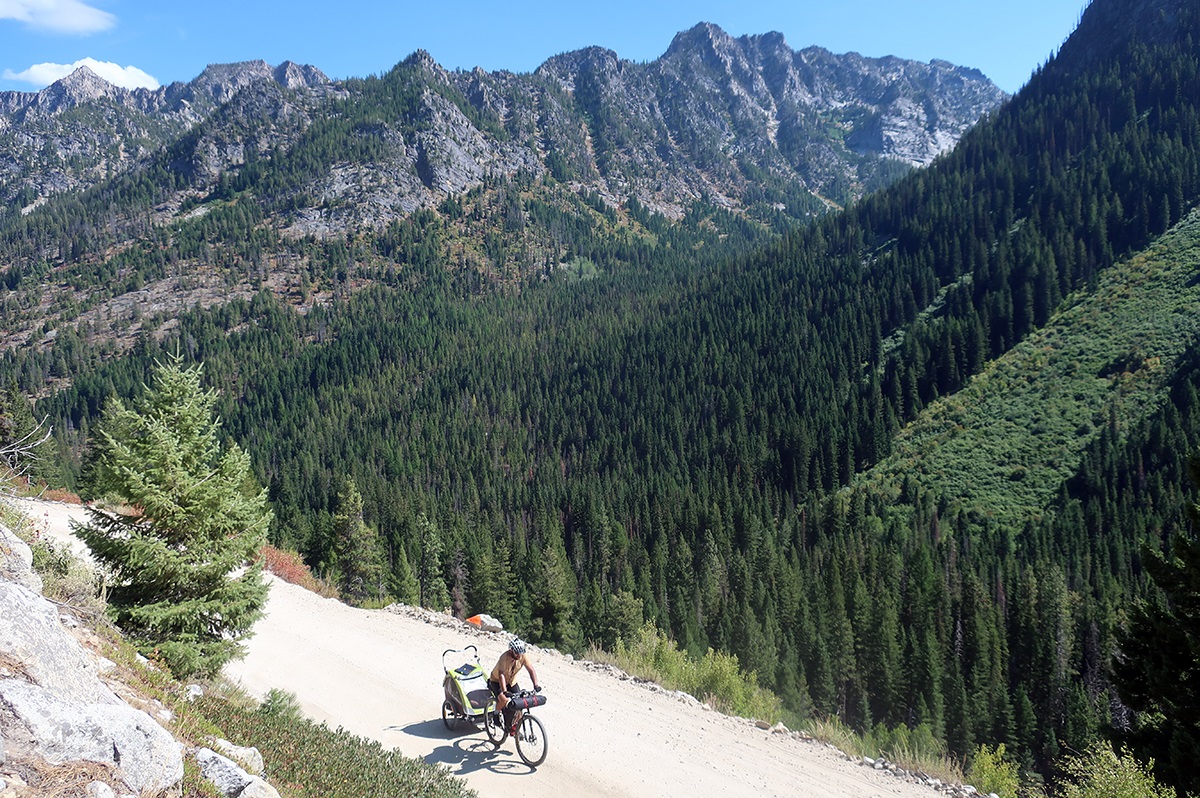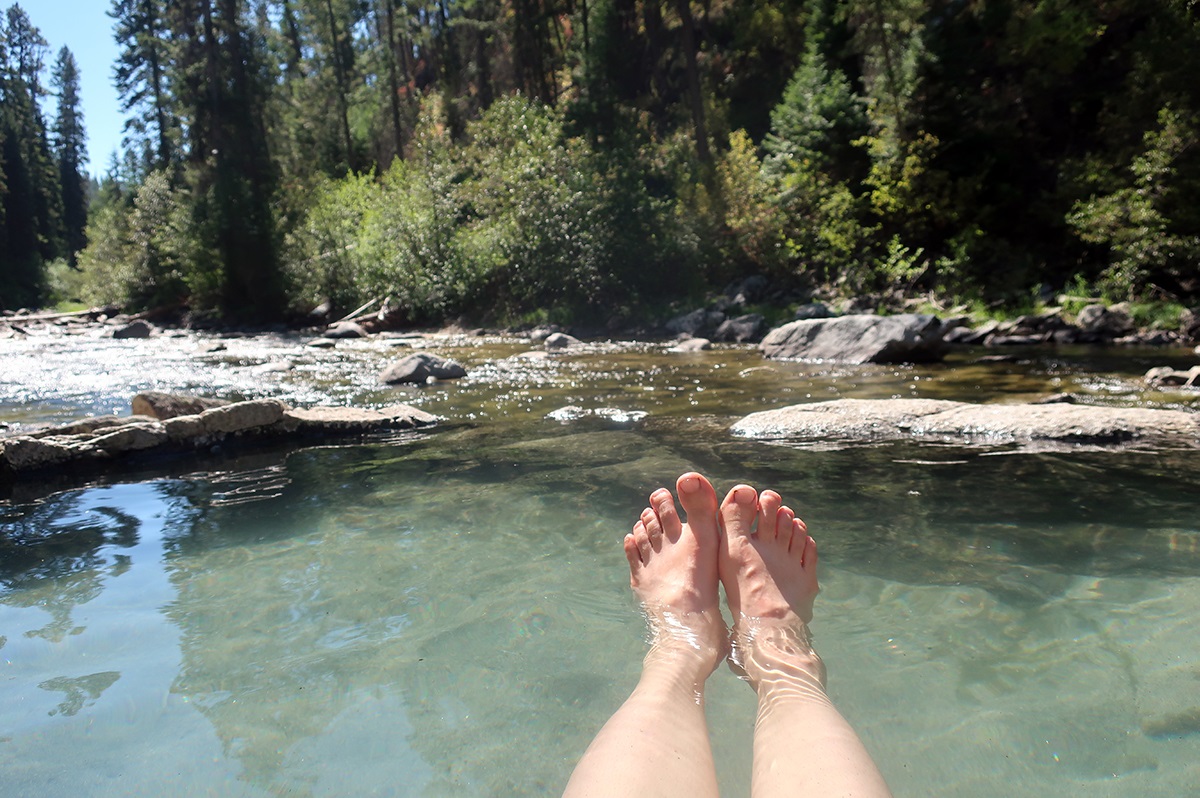Dipping into the Idaho Hot Springs Route — with Kids!
“Can we pull this off?” I wondered a couple of days before leaving on a week-long bike trip along the Idaho Hot Springs Mountain Bike Route. We’d been looking forward to the trip for months as a way to get off the grid, spend some quality time as a family, and immerse our two-year-old in the outdoor and biking worlds that had brought my husband and me together. We’d even convinced another family (with a three-year-old and seven-month-old) to come along. It would be their first time on a bike trip with kids.
The Idaho Hot Springs Mountain Bike Route seemed like a perfect choice for a family bike trip. Getting into the backcountry had become much more difficult with a kid, but the low-traffic, mostly dirt roads of this route felt safe and easy enough for us to haul a child and gear in a bike trailer. At the same time, the route looked rugged enough to scratch our backcountry itch. Plus, the enticing hot springs topped it off!
Our plan was to ride a 130-mile loop, starting and ending in McCall, Idaho. We aimed for 20-30 miles a day, with five days of riding and two rest days. Since the route runs consistently through national forest land, we could be flexible each day, camping at one of the many dispersed sites whenever we felt done for the day. In the planning process, we scoped out multiple dispersed sites via satellite imagery just to be safe.
If we were able to complete the daily mileage we hoped for, our rest days would be a relaxing and fun way to enjoy the area even more: hiking, hot spring soaking, letting kids play around the campsite. If we were not able to make the daily planned mileage, we could use a rest day to make it up. We weren’t sure whether this schedule would allow for the multiple breaks we knew the kids would need and give us space for the unexpected, such as bad road conditions, inclement weather, meltdowns … whatever the kids or the world would throw at us. But we would find out.

A few days before departure, the logistics of preparing for a remote bikepacking trip while working full time, performing life maintenance, and taking care of a kid began to overwhelm us. Doubts crept in. Would we be able to cover enough miles to make it back to our car? What if one of us had a serious injury? What if we forgot something we needed? And yet, after packing late into the night and arguing about what food to bring and what gear to leave behind, we made it out the door with hesitant optimism. We were going to do this!
The other family joined us for the first four days of the trip, bringing along a SAG vehicle, which the adults took turns driving. This proved to be an excellent resource on a remote trip where there was only one, very limited convenience store for resupply. While we could have carried the whole week’s worth of food without a SAG, the meals would have been dehydrated and required more planning. Instead, we feasted well those first four days.
The SAG vehicle also shuttled the kids across the one, somewhat busy road on our route, Warm Lake Road – a cutoff road we used to create a smaller loop. It was paved, high-speed, and had little to no shoulder. Even with low traffic, we felt more comfortable shuttling the kids along this stretch of road. Luckily, we didn’t need the vehicle for the other concerns, like bad weather and injuries.
Along with the variety of food in the first half of the trip, the terrain too was ever-changing. We encountered everything: smooth roads with moderate traffic, sandy washboard roads with almost no traffic, exhausting climbs, and the most amazing paved forest service road with stunning views of the South Fork of the Salmon River.

The kids responded in kind. They melted down, then shrieked with excitement while playing at the river’s edge; they cried at having to get back in the bike trailer, then sang songs inside it. There were more stars than one could believe, and of course, relaxing hot springs to soak in. Some of the springs even had pools cool enough for the kids to play in. The route was definitely scratching that itch.
The second half of the trip, when our family would be totally on our own, made me nervous. While we chose dehydrated food and to go light on water — always knowing where the next creek would be so we could filter more — the trailer, with its gear and two-year-old, weighed about 60 pounds, not to mention the weight of the bikes and the rest of our gear and food. The next mountain pass loomed formidably.
As we headed up and up without the comfort of the SAG vehicle and our friends, the road became rough. We pedaled very slowly and took many breaks. By late afternoon we’d made it a mere 15 miles. That was far enough. We figured adding an extra five miles to our last day, which was mostly downhill and partly paved, would be better than pushing ourselves further.
While climbing the pass was physically difficult, it was also the most gorgeous section of the trip. Surrounded by rugged, glacier-carved granite peaks and formations, we rode higher and higher to get better views of it all.
After the big climb, we took a day off and hiked to a calm, glassy lake surrounded by the granite boulders of the Salmon River Mountains. Then, with elation and some reluctance, we rode our final day, almost all downhill, back to McCall. The trip had been a success!

While there were difficult moments, what really stuck with us was the beauty of the area, the hot spring soaks, the kids splashing around and throwing rocks in the river, quality time with family and friends in the woods, and the accomplishment of a trip well-ridden. On the drive home, we were already dreaming up future adventures.
Tips for Cycling a Remote Route with Kids
- Bring a satellite communication device like a Garmin InReach or Spot. These allow you to send and receive text messages outside of cell service. If there is a true emergency, you can send your location to emergency services. The weather feature on the InReach has also come in handy.
- Allow extra time each day for kids to take breaks and for unexpected issues.
- Plan at least one rest day which can be used for rest and exploration if not needed for other purposes.
- You don’t need to haul many toys for the kiddos. One of your cooking pans with some sticks and leaves can keep kids entertained. Breaks from the trailer give them lots of opportunities to enjoy the natural toys found outdoors. For the trailer, we brought five legos, a stuffed animal, a small blankie, and a few “Indestructibles” books. We also sang a lot of songs as we rode.


